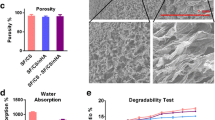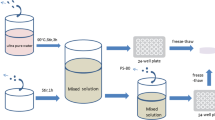Abstract
Using tissue engineering techniques, an artificial osteochondral construct was successfully fabricated to treat large osteochondral defects. In this study, porcine cancellous bones and chitosan/gelatin hydrogel scaffolds were used as substitutes to mimic bone and cartilage, respectively. The porosity and distribution of pore size in porcine bone was measured and the degradation ratio and swelling ratio for chitosan/gelatin hydrogel scaffolds was also determined in vitro. Surface morphology was analyzed with the scanning electron microscope (SEM). The physicochemical properties and the composition were tested by using an infrared instrument. A double layer composite scaffold was constructed via seeding adipose-derived stem cells (ADSCs) induced to chondrocytes and osteoblasts, followed by inoculation in cancellous bones and hydrogel scaffolds. Cell proliferation was assessed through Dead/Live staining and cellular activity was analyzed with IpWin5 software. Cell growth, adhesion and formation of extracellular matrix in composite scaffolds blank cancellous bones or hydrogel scaffolds were also analyzed. SEM analysis revealed a super porous internal structure of cancellous bone scaffolds and pore size was measured at an average of 410 ± 59 μm while porosity was recorded at 70.6 ± 1.7 %. In the hydrogel scaffold, the average pore size was measured at 117 ± 21 μm and the porosity and swelling rate were recorded at 83.4 ± 0.8 % and 362.0 ± 2.4 %, respectively. Furthermore, the remaining hydrogel weighed 80.76 ± 1.6 % of the original dry weight after hydration in PBS for 6 weeks. In summary, the cancellous bone and hydrogel composite scaffold is a promising biomaterial which shows an essential physical performance and strength with excellent osteochondral tissue interaction in situ. ADSCs are a suitable cell source for osteochondral composite reconstruction. Moreover, the bi-layered scaffold significantly enhanced cell proliferation compared to the cells seeded on either single scaffold. Therefore, a bi-layered composite scaffold is an appropriate candidate for fabrication of osteochondral tissue.









Similar content being viewed by others
References
Ho ST, Hutmacher DW, Ekaputra AK, Hitendra D, Hui JH. The evaluation of a biphasic osteochondral implant coupled with an electrospun membrane in a large animal model. Tissue Eng Part A. 2010;16(4):1123–41.
Luo Z, Jiang L, Xu Y, Li H, Xu W, Wu S, Wang Y, Tang Z, Lv Y, Yang L. Mechano growth factor (MGF) and transforming growth factor (TGF)-β3 functionalized silk scaffolds enhance articular hyaline cartilage regeneration in rabbit model. Biomaterials. 2015;52:463–75.
Enea D, Cecconi S, Calcagno S, Busilacchi A, Manzotti S, Gigante A. One-step cartilage repair in the knee: collagen-covered microfracture and autologous bone marrow concentrate. A pilot study. Knee. 2015;22(1):30–5.
Steinwachs MR, Waibl B, Mumme M. Arthroscopic treatment of cartilage lesions with microfracture and BST-CarGel. Arthrosc Tech. 2014;3(3):e399–402.
Tang C, Jin C, Du X, Yan C, Min BH, Xu Y, Wang L. An autologous bone marrow mesenchymal stem cell-derived extracellular matrix scaffold applied with bone marrow stimulation for cartilage repair. Tissue Eng Part A. 2014;20(17–18):2455–62.
Damm P, Bender A, Bergmann G. Postoperative changes in in vivo measured friction in total hip joint prosthesis during walking. PLoS One. 2015;10(3):e0120438.
Godzik J, Ravindra VM, Ray WZ, Schmidt MH, Bisson EF, Dailey AT. Comparison of structural allograft and traditional autograft technique in occipitocervical fusion: radiological and clinical outcomes from a single institution. J Neurosurg Spine. 2015;23(2):144–52.
Abou-Khalil R, Yang F, Lieu S, Julien A, Perry J, Pereira C, Relaix F, Miclau T, Marcucio R, Colnot C. Role of muscle stem cells during skeletal regeneration. Stem Cells. 2015;33(5):1501–11.
Perdisa F, Filardo G, Di Matteo B, Marcacci M, Kon E. Platelet rich plasma: a valid augmentation for cartilage scaffolds? A systematic review. Histol Histopathol. 2014;29(7):805–14.
Chia SL, Gorna K, Gogolewski S, Alini M. Biodegradable elastomeric polyurethane membranes as chondrocyte carriers for cartilage repair. Tissue Eng. 2006;12(7):1945–53.
Cao Y, Vacanti JP, Paige KT, Upton J, Vacanti CA. Transplantation of chondrocytes utilizing a polymer-cell construct to produce tissue-engineered cartilage in the shape of a human ear. Plast Reconstr Surg. 1997;100(2):297–302.
Solchaga LA, Yoo JU, Lundberg M, Dennis JE, Huibregtse BA, Goldberg VM, Caplan AI. Hyaluronan-based polymers in the treatment of osteochondral defects. J Orthop Res. 2000;18(5):773–80.
Fields AJ, Sahli F, Rodriguez AG, Lotz JC. Seeing double: a comparison of microstructure, biomechanical function, and adjacent disc health between double- and single-layer vertebral endplates. Spine (Phila Pa 1976). 2012;37(21):E1310-7.
Basad E, Stürz H, Steinmeyer J. Treatment of osteochondral defects of the knee with autologous bone graft and chondrocyte transplantation: an overview together with our results. Acta Orthop Traumatol Turc. 2007;41(Suppl 2):79–86.
Song K, Li L, Li W, Zhu Y, Jiao Z, Lim M, Fang M, Shi F, Wang L, Liu T. Three-dimensional dynamic fabrication of engineered cartilage based on chitosan/gelatin hybrid hydrogel scaffold in a spinner flask with a special designed steel frame. Mater Sci Eng C Mater Biol Appl. 2015;55:384–92.
Ren Y, Han C, Wang J, Jia Y, Kong L, Eerdun T, Wu L, Jiang D, Ren Y, Han C, Wang J, Kong L, Jia Y, Eerdun T, Wu L, Jiang D. Identification of genes associated with the differentiation potential of adipose-derived stem cells to osteocytes or myocytes. Mol Cell Biochem. 2015;400(1–2):135–44.
Song K, Wang Z, Li W, Zhang C, Lim M, Liu T. In vitro culture, determination, and directed differentiation of adult adipose-derived stem cells towards cardiomyocyte-like cells induced by angiotensin II. Appl Biochem Biotechnol. 2013;170(2):459–70.
Karaoz E, Okcu A, Ünal ZS, Subasi C, Saglam O, Duruksu G. Adipose tissue-derived mesenchymal stromal cells efficiently differentiate into insulin-producing cells in pancreatic islet microenvironment both in vitro and in vivo. Cytotherapy. 2013;15(5):557–70.
Lee JW, Cho DW. 3D Printing technology over a drug delivery for tissue engineering. Curr Pharm Des. 2015;21(12):1606–17.
Liu X, Wang P, Chen W, Weir MD, Bao C, Xu HH. Human embryonic stem cells and macroporous calcium phosphate construct for bone regeneration in cranial defects in rats. Acta Biomater. 2014;10(10):4484–93.
Filardo G, Kon E, Roffi A, Di Martino A, Marcacci M. Scaffold-based repair for cartilage healing: a systematic review and technical note. Arthroscopy. 2013;29(1):174–86.
van der Kraan PM, van den Berg WB. Chondrocyte hypertrophy and osteoarthritis: role in initiation and progression of cartilage degeneration? [J]. Osteoarthr Cartil. 2012;20(3):223–32.
Song K, Li W, Zhu Y, Wang H, Yu Z, Lim M, Liu T. Dynamic fabrication of tissue-engineered bone substitutes based on derived cancellous bone scaffold in a spinner flask bioreactor system. Appl Biochem Biotechnol. 2014;174(4):1331–43.
Song K, Liu Y, Macedo HM, Jiang L, Li C, Mei G, Liu T. Fabrication and evaluation of a sustained-release chitosan-based scaffold embedded with PLGA microspheres. Mater Sci Eng C Mater Biol Appl. 2013;33(3):1506–13.
Zhu Y, Liu T, Song K, Fan X, Ma X, Cui Z. Adipose-derived stem cell: a better stem cell than BMSC. Cell Biochem Funct. 2008;26(6):664–75.
Qu X, Liu T, Song K, Li X, Ge D. Differentiation of reprogrammed human adipose mesenchymal stem cells toward neural cells with defined transcription factors. Biochem Biophys Res Commun. 2013;439(4):552–8.
Song K, Li W, Wang H, Wang H, Liu T, Ning R, Wang L. Investigation of coculture of human adipose-derived stem cells and mature adipocytes. Appl Biochem Biotechnol. 2012;167(8):2381–7.
Chien KB, Makridakis E, Shah RN. Three-dimensional printing of soy protein scaffolds for tissue regeneration. Tissue Eng Part C Methods. 2013;19(6):417–26.
Faia-Torres AB, Guimond-Lischer S, Rottmar M, Charnley M, Goren T, Maniura-Weber K, Spencer ND, Reis RL, Textor M, Neves NM. Differential regulation of osteogenic differentiation of stem cells on surface roughness gradients. Biomaterials. 2014;35(33):9023–32.
Link DP, Gardel LS, Correlo VM, Gomes ME, Reis RL. Osteogenic properties of starch poly (ε-caprolactone) (SPCL) fiber meshes loaded with osteoblast-like cells in a rat critical-sized cranial defect. J Biomed Mater Res A. 2013;101(11):3059–65.
Nooeaid P, Salih V, Beier JP, Boccaccini AR. Osteochondral tissue engineering: scaffolds, stem cells and applications. Cell Mol Med. 2012;16(10):2247–70.
Liu H, Roy K. Biomimetic three-dimensional cultures significantly increase hematopoietic differentiation efficacy of embryonic stem cells. Tissue Eng. 2005;11(1–2):319–30.
Sams AE, Monir RR, Wootton JA, Mohammed H, Nixon AJ. Local and remote matrix responses to chondrocyte-laden collagen scaffold implantation in extensive articular cartilage defect. Osteoarthr Cartil. 1995;3(1):61–70.
Kawamura S, Makitani S, Kimura T, Maeda A, Caplan AI, Shino K, Ochi T. Articular cartilage repair rabbit experiments with a collagen gel-biomatrix and chondrocytes cultured in it. Acta Orthop Scand. 1998;69(1):56–62.
Wang F. Bionic design and initial preparation of tissue engineered osteochondral composites [D]. Third Military Medical University, 2008.
Cao S, Zhao G, Yan W. The cancellous bone graft substitute porosity tested by the micro CT image method and the biopsy image method. Beijing Biomed Eng. 2012;31(005):478–81.
Strem BM, Hicok KC, Zhu M, Wulur I, Alfonso Z, Schreiber RE, Fraser JK, Hedrick MH. Multipotential differentiation of adipose tissue-derived stem cells. Keio J Med. 2005;54(3):132–41.
Sterodimas A, de Faria J, Nicaretta B, Pitanguy I. Tissue engineering with adipose-derived stem cells (ADSCs): current and future applications. J Plast Reconstr Aesthet Surg. 2010;63:1886–92.
Song K, Yang Y, Xu L, Tian J, Fan J, Jiao Z, Feng S, Wang H, Wang Y, Wang L, Liu T. Fabrication and detection of tissue engineered bone aggregates based on encapsulated human ADSCs within hybrid calcium alginate/bone powder gel-beads in a spinner flask. Mater Sci Eng C. 2016;62:787–94.
Mesimäki K, Lindroos B, Törnwall J, Mauno J, Lindqvist C, Kontio R, Miettinen S, Suuronen R. Novel maxillary reconstruction with ectopic bone formation by GMP adipose stem cells. Int J Oral Maxillofac Surg. 2009;38:201–9.
Cheng NC, Wang S, Young TH. The influence of spheroid formation of human adipose-derived stem cells on chitosan films on stemness and differentiation capabilities. Biomaterials. 2012;33(6):1748–58.
Lee AY, Lee J, Kim CL, Lee KS, Lee SH, Gu NY, Kim JM, Lee BC, Koo OJ, Song JY, Cha SH. Comparative studies on proliferation, molecular markers and differentiation potential of mesenchymal stem cells from various tissues (adipose, bone marrow, ear skin, abdominal skin, and lung) and maintenance of multipotency during serial passages in miniature pig. Res Vet Sci. 2015;100:115–24.
Lu T, Xiong H, Wang K, Wang S, Ma Y, Guan W. Isolation and characterization of adipose-derived mesenchymal stem cells (ADSCs) from cattle. Appl Biochem Biotechnol. 2014;174(2):719–28.
Mohan N, Dormer NH, Caldwell KL, Key VH, Berkland CJ, Detamore MS. Continuous gradients of material composition and growth factors for effective regeneration of the osteochondral interface. Tissue Eng Part A. 2011;17(21–22):2845–55.
Khanarian NT, Jiang J, Wan LQ, Mow VC, Lu H. A hydrogel-mineral composite scaffold for osteochondral interface tissue engineering. Tissue Eng Part A. 2012;18(5–6):533–45.
Filová E, Jelínek F, Handl M, Lytvynets A, Rampichova M, Varga F, Činátl J, Soukup T, Trč T, Amler E. Novel composite hyaluronan/type I collagen/fibrin scaffold enhances repair of osteochondral defect in rabbit knee. Biomed Mater Res B Appl Biomater. 2008;87(2):415–24.
Schek RM, Taboas JM, Segvich SJ, Hollister SJ, Krebsbach PH. Engineered osteochondral grafts using biphasic composite solid free-form fabricated scaffolds. Tissue Eng. 2004;10(9–10):1376–85.
Acknowledgments
The present work was supported by Fok Ying Tung Education Foundation (132027), National Science Foundation of China (31370991/31170945/81271719/81341060), the Joint Open Foundation of Natural Science Foundation of Liaoning and Shenyang National Laboratory for Materials Science (2015021017) and the Fundamental Research Funds for the Central Universities (DUT14YQ106/15GY47/16ZD210), SRF for ROCS, SEM.
Author information
Authors and Affiliations
Corresponding authors
Ethics declarations
Conflict of interest
The authors have no conflicts of interest.
Rights and permissions
About this article
Cite this article
Song, K., Li, L., Yan, X. et al. Fabrication and development of artificial osteochondral constructs based on cancellous bone/hydrogel hybrid scaffold. J Mater Sci: Mater Med 27, 114 (2016). https://doi.org/10.1007/s10856-016-5722-5
Received:
Accepted:
Published:
DOI: https://doi.org/10.1007/s10856-016-5722-5




